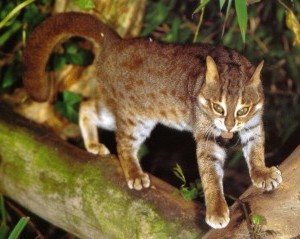|
Weight: 6-9 pounds´┐Ż
Head/Body: 17 inches´┐Ż
Tail: 7 inches´┐Ż
Subspecies: 2
The Rusty-spotted Cat is indigenous to South and/or Central India, and Sri Lanka. There are two types of populations. The Sri Lankan cats move in the thick tropical forests at high altitudes, while in India they can be seen on dry grass grounds and forests.
Rusty-spotted Cats are among the smallest wild cats. The base fur is usually grey in color and is covered by small rust red colored spots which form into solid stripes along the back and on the top of the head. The underparts of the body, the chest bib and the chin are white.
A Rusty-spotted Cat's gestation season is around 70 days, with one to two offspring typically born in April. Their diet consists of mammals, birds, reptiles and insects. They consume frogs after a rainfall.
Most of the time, the Rusty-spotted Cat is nocturnal, content to rest in hollow logs during the daylight hours. Experts believe that they are above-average climbers, and they leave urine elements within their established "turf".
The main threat to the rusty-spotted cat is that of habitat loss, although trade in furs is present in parts of its range.
The Rusty-spotted cat is listed as Vulnerable (VU) on the IUCN Red List of Threatened Species, considered to be facing a high risk of extinction in the wild. The Indian subspecies are listed in CITES Appendix I and the Sri Lankan sub-species in CITES Appendix II.

|



